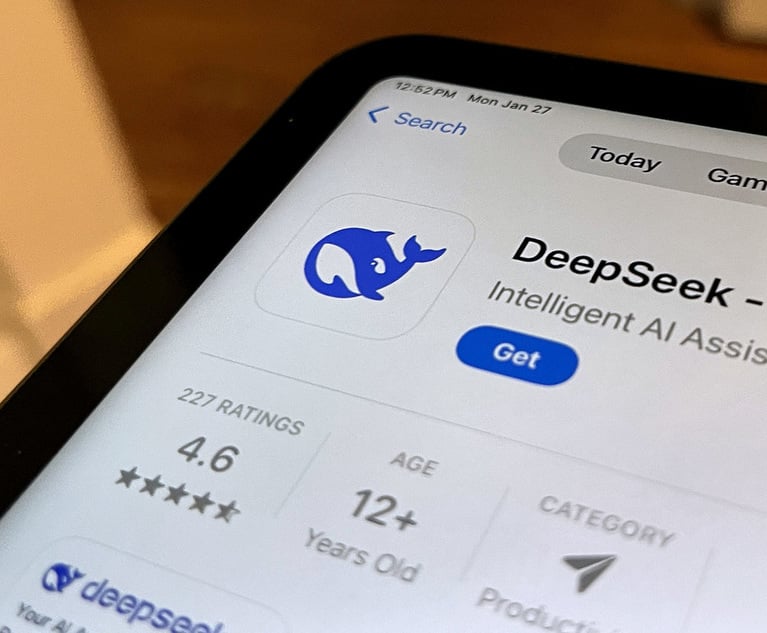What Does the Big 4's Legal Tech Push Mean for Law Firms?
As the Big 4 accounting companies are starting to invest more heavily in legal tech, will law firms need to stay on their toes to remain relevant?
February 25, 2019 at 09:00 AM
4 minute read
The original version of this story was published on Law.com

The race to legal tech is certainly picking up speed. News broke earlier this week that the accounting firm of EY had inked a deal to begin using AI contract review platform Luminance inside of its global legal network, making it the third of the Big 4 accounting firms to adopt the legal machine learning platform.
The move comes just a few months after EY acquired the alternative legal services provider Riverview Law, signaling a deeper commitment to the managed legal services track. EY isn't the only Big 4 member building ties to the legal tech industry either. Earlier this month, an alliance between Deloitte and e-discovery software provider Relativity spawned a workflow platform geared toward managing Freedom of Information Act requests.
Unless accounting companies are planning on tossing all of this legal tech in a garage somewhere until the next rainy day, law firms may have to move faster to distinguish the types of client services they provide in an increasingly crowded marketplace.
"With three of the Big Four accountancy firms now using Luminance, we are witnessing a seismic shift in the legal landscape as law firms need to innovate to keep pace," said Emily Foges, CEO of Luminance.
So to what exactly can such a "seismic shift" be attributed? Cornelius Grossmann, global law leader for EY, pointed to a need among clients to do more with less, which more often than not means selecting partners or service providers that have a technology focus.
Luminance, for example, is being deployed within EY's contract and due diligence teams. The goal is to pick up the pace and deliver results more quickly and efficiently within the company's menagerie of managed legal services.
"This is a big growth area for us, absolutely. This is a trend in the market. It's growing rapidly and we are heavily investing," Grossmann said.
He considers the legal managed services aspect of EY's business to be different from the track taken by traditional law firms, which Grossmann characterized as operating in the "high-end legal advice" domain.
If that's true, then the real question may be how much longer law firms can afford to operate that way once high-end advice starts looking like less of a niche. Per Grossmann, EY is already making strides on the advisory side of the equation by onboarding legal talent to service clients and fill in any gaps left by technology.
"But at the same time we're investing heavily in legal operations, which is really our new line of business, which is where we address the needs of legal functions which are not directly related to the main knowledge," Grossmann said.
To be sure, law firms are investing in those resources too. The firm of Bird & Bird, for example, also employs Luminance. However, according to IT director Karen Jacks, clients rarely ask for a specific brand of legal tech by name. Instead, they express the same interest in efficiency and expediency that Grossmann identified at EY.
When it comes to actually investing in new technologies, though, the playing field may not be entirely level.
"That's quite difficult because the Big 4 have probably got much bigger pockets than we do," Jacks said.
But nobody is throwing in the towel just yet. Kathryn Pearson, head of knowledge and client service solutions at Bird & Bird, thinks that some of the most innovative things a firm can do with regard to efficiency involve simply re-evaluating existing workflows rather than a relying on a technical assist.
Both Pearson and Jacks have noticed a shift in the way that law firms are approaching their relationships with clients. It's less of a straight delivery of the law than it is an ongoing, exploratory partnership in the discovery of new ideas.
"My role has certainly evolved in the last few years from not just managing our client platform but also working more closely with my IT colleagues in the wider business to look at products more generally and also [looking at] the problems that people are trying to solve," Pearson said.
This content has been archived. It is available through our partners, LexisNexis® and Bloomberg Law.
To view this content, please continue to their sites.
Not a Lexis Subscriber?
Subscribe Now
Not a Bloomberg Law Subscriber?
Subscribe Now
NOT FOR REPRINT
© 2025 ALM Global, LLC, All Rights Reserved. Request academic re-use from www.copyright.com. All other uses, submit a request to [email protected]. For more information visit Asset & Logo Licensing.
You Might Like
View All
DeepSeek and the AI Revolution: Why One Legal Tech Expert Is Hitting Pause
4 minute read
What Happens When a Lateral Partner's Guaranteed Compensation Ends?

Lawyers React To India’s 2025 Budget, Welcome Investment And Tax Reform

Russia’s Legal Sector Is Changing as Western Sanctions Take Their Toll
5 minute readTrending Stories
- 1States Accuse Trump of Thwarting Court's Funding Restoration Order
- 2Microsoft Becomes Latest Tech Company to Face Claims of Stealing Marketing Commissions From Influencers
- 3Coral Gables Attorney Busted for Stalking Lawyer
- 4Trump's DOJ Delays Releasing Jan. 6 FBI Agents List Under Consent Order
- 5Securities Report Says That 2024 Settlements Passed a Total of $5.2B
Who Got The Work
J. Brugh Lower of Gibbons has entered an appearance for industrial equipment supplier Devco Corporation in a pending trademark infringement lawsuit. The suit, accusing the defendant of selling knock-off Graco products, was filed Dec. 18 in New Jersey District Court by Rivkin Radler on behalf of Graco Inc. and Graco Minnesota. The case, assigned to U.S. District Judge Zahid N. Quraishi, is 3:24-cv-11294, Graco Inc. et al v. Devco Corporation.
Who Got The Work
Rebecca Maller-Stein and Kent A. Yalowitz of Arnold & Porter Kaye Scholer have entered their appearances for Hanaco Venture Capital and its executives, Lior Prosor and David Frankel, in a pending securities lawsuit. The action, filed on Dec. 24 in New York Southern District Court by Zell, Aron & Co. on behalf of Goldeneye Advisors, accuses the defendants of negligently and fraudulently managing the plaintiff's $1 million investment. The case, assigned to U.S. District Judge Vernon S. Broderick, is 1:24-cv-09918, Goldeneye Advisors, LLC v. Hanaco Venture Capital, Ltd. et al.
Who Got The Work
Attorneys from A&O Shearman has stepped in as defense counsel for Toronto-Dominion Bank and other defendants in a pending securities class action. The suit, filed Dec. 11 in New York Southern District Court by Bleichmar Fonti & Auld, accuses the defendants of concealing the bank's 'pervasive' deficiencies in regards to its compliance with the Bank Secrecy Act and the quality of its anti-money laundering controls. The case, assigned to U.S. District Judge Arun Subramanian, is 1:24-cv-09445, Gonzalez v. The Toronto-Dominion Bank et al.
Who Got The Work
Crown Castle International, a Pennsylvania company providing shared communications infrastructure, has turned to Luke D. Wolf of Gordon Rees Scully Mansukhani to fend off a pending breach-of-contract lawsuit. The court action, filed Nov. 25 in Michigan Eastern District Court by Hooper Hathaway PC on behalf of The Town Residences LLC, accuses Crown Castle of failing to transfer approximately $30,000 in utility payments from T-Mobile in breach of a roof-top lease and assignment agreement. The case, assigned to U.S. District Judge Susan K. Declercq, is 2:24-cv-13131, The Town Residences LLC v. T-Mobile US, Inc. et al.
Who Got The Work
Wilfred P. Coronato and Daniel M. Schwartz of McCarter & English have stepped in as defense counsel to Electrolux Home Products Inc. in a pending product liability lawsuit. The court action, filed Nov. 26 in New York Eastern District Court by Poulos Lopiccolo PC and Nagel Rice LLP on behalf of David Stern, alleges that the defendant's refrigerators’ drawers and shelving repeatedly break and fall apart within months after purchase. The case, assigned to U.S. District Judge Joan M. Azrack, is 2:24-cv-08204, Stern v. Electrolux Home Products, Inc.
Featured Firms
Law Offices of Gary Martin Hays & Associates, P.C.
(470) 294-1674
Law Offices of Mark E. Salomone
(857) 444-6468
Smith & Hassler
(713) 739-1250








